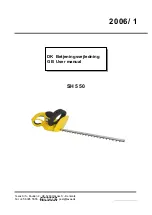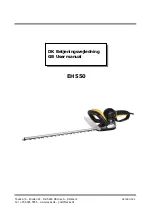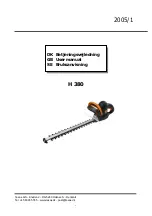
8 — English
FORCE FEEDING
See Figure 9, page 12.
The router is an extremely high-speed tool (29,000 RPM),
and will make clean, smooth cuts if allowed to run freely
without the overload of a forced feed. Three things that
cause force feeding are bit size, depth of cut, and workpiece
characteristics. The larger the bit or the deeper the cut, the
more slowly the router should be moved forward. If the
wood is very hard, knotty, gummy or damp, the operation
must be slowed still more.
Clean smooth trimming and edge shaping can be done
only when the bit is revolving at a relatively high speed and
is taking very small bites to produce tiny, cleanly-severed
chips. If the router is forced to move forward too fast, the
speed of the bit becomes slower than normal in relation to
its forward movement. As a result, the bit must take bigger
bites as it revolves. Bigger bites mean bigger chips and a
rougher finish. Bigger chips also require more power, which
could result in overheating of the motor and lower battery
life.
Under extreme force-feeding conditions, the relative speed
of the bit can become so slow – and the bites it has to take
so large – that chips will be partially knocked off rather than
fully cut off. This will result in splintering and gouging of the
workpiece and will likely damage the tool.
FEEDING TOO SLOWLY
See Figure 9, page 12.
When the router is advanced into the work too slowly it
scrapes away sawdust-like particles instead of cleanly
cutting into the workpiece. Scraping produces heat, which
can glaze, burn, or mar the cut, and can overheat the bit.
Dull bits can also contribute to scraping and burning.
It is more difficult to control a router when the bit is scraping
instead of cutting. With practically no load on the motor,
the bit will be revolving near top RPM. When feeding too
slowly, the bit will have a greater than normal tendency to
bounce off the sides of the cut, especially if the wood has
a pronounced grain with hard and soft areas. The cut that
results may have rippled sides instead of straight.
DEPTH OF CUT
See Figure 10, page 12.
WARNING:
If the desired depth of cut is greater than can be safely
cut in one pass, make cuts in two or more passes. Do
not remove more than 1/8 in. in a single pass. Excessive
depth of cut can result in loss of control and the possibility
of serious personal injury.
Depth of cut affects the rate of feed and the quality of a cut.
Using the proper depth of cut can lessen the possibility of
damage to the router motor and bit.
A deeper cut requires a slower feed than a shallow one.
Making a cut that is too deep will slow the feed so that the
bit is scraping, rather than cutting, and is not recommended.
A too-deep cut can cause smaller bits to be broken off.
bits that are 1/16 in. in diameter are easily broken off when
subjected to too much side thrust. A larger bit is not as
likely to break, but attempting a cut that is too deep may
result in a rough cut, and may make it difficult to guide and
control the bit as desired.
It is necessary that you do not exceed 1/8 in. depth of cut
in a single pass, regardless of the bit size or the softness
or condition of the workpiece. This will result in a higher
quality cut.
To make deeper cuts, it is necessary to make as many
successive passes as required, lowering the bit 1/8 in
for each new pass. To save time, perform all the cutting
necessary at one depth setting, then lower the bit for the
next pass. This will assure uniform depth when the final
pass is completed.
ATTACHING THE ROUND SUBBASE (NOT
INCLUDED)
See Figure 11, page 12.
Remove the battery pack.
Turn the router upside down to remove the four subbase
screws and the square subbase.
Attach the round subbase using the same screws.
Tighten the screws securely. Do not over tighten.
WARNING:
Always use the base for laminate trimming. Use of the
router without a base or using the incorrect base can
result in serious personal injury.
USING EDGE GUIDE (NOT INCLUDED)
See Figures 12 - 13, page 12.
Use the edge guide to trim or cut a straight or curved edge.
Remove the battery pack.
Thread guide bars into the base and tighten with a flat
head screwdriver.
Slide the edge guide onto the guide bars.
Install thumb screws provided into the edge guide.
Measure the proper distance to offset the bit, or if trim-
ming, position the bit at the edge of the workpiece.
Tighten the two thumb screws to secure the edge guide.
Reinstall the battery pack.
Move the router along the workpiece keeping the edge
guide in constant contact with edge of the workpiece.
OPERATION
Содержание P601
Страница 29: ...13 NOTES NOTES NOTAS ...
Страница 30: ...14 NOTES NOTES NOTAS ...
Страница 31: ...15 NOTES NOTES NOTAS ...









































